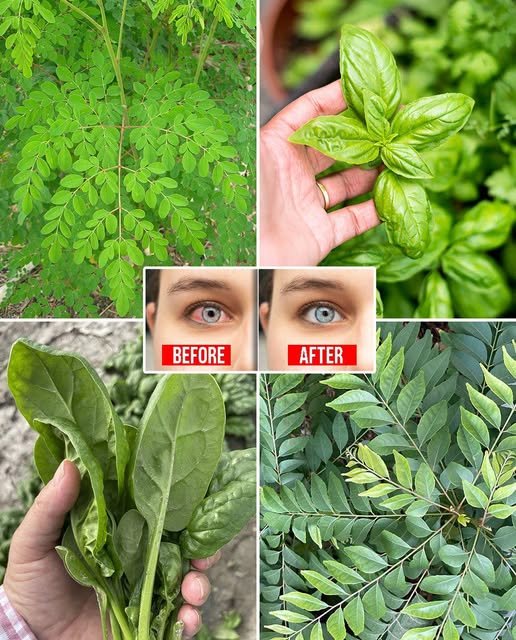In a world dominated by screens and digital strain, maintaining strong, healthy eyesight has never been more important. While most people turn to supplements and eye drops, nature offers a rich pharmacy of plant-based remedies — including certain leaves that can nourish and protect your vision from the inside out.
Rich in antioxidants, carotenoids, vitamins, and anti-inflammatory compounds, these five powerful leaves have been traditionally used across cultures to support eye health naturally. Let’s explore each one, its unique properties, and how to consume it effectively.
1. Moringa Leaves – The Multivitamin Tree
Nicknamed the “Miracle Tree”, moringa (Moringa oleifera) is an ancient plant loaded with vitamin A, beta-carotene, lutein, zeaxanthin, and powerful antioxidants that directly benefit the eyes.
How It Helps:
- Vitamin A helps prevent night blindness and dry eyes.
- Lutein and zeaxanthin protect the retina from harmful blue light and oxidative stress.
- Reduces inflammation that can impair vision over time.
How to Use:
- Fresh leaves: Add to soups, curries, or steam like spinach.
- Powder form: Mix 1 tsp in smoothies or warm water daily.
- Tea: Steep dried moringa leaves for 10 minutes and drink regularly.
2. Curry Leaves – The Guardian of Retinal Cells
Common in Indian cuisine, curry leaves (Murraya koenigii) are rich in vitamin A, B, C, calcium, and iron — all of which nourish eye tissues and slow degenerative processes like macular degeneration.
How It Helps:
- Prevents corneal dryness and strengthens retinal membranes.
- Iron supports blood flow to ocular nerves.
- Antioxidants neutralize free radicals that damage vision.
How to Use:
- Fresh: Use in cooking or chew 5–10 leaves in the morning.
- Dried: Make curry leaf tea or add powder to meals.
3. Spinach Leaves – A Lutein Powerhouse
Though commonly known as a vegetable, spinach (Spinacia oleracea) leaves offer incredible eye support. It’s one of the richest plant sources of lutein and zeaxanthin, which concentrate in the retina and lens.
How It Helps:
- Filters harmful UV and blue light.
- Prevents cataracts and age-related macular degeneration (AMD).
- High in vitamin C and E, essential for collagen in the eye.
How to Use:
- Raw: In salads or green juices.
- Lightly steamed: To enhance lutein absorption.
- Smoothies: Combine with citrus fruits for better vitamin C synergy.
4. Sweet Basil Leaves – The Anti-Inflammatory Healer
Often overlooked for its eye benefits, sweet basil (Ocimum basilicum) contains vitamin A, beta-carotene, and essential oils with antibacterial and anti-inflammatory effects.
How It Helps:
- Soothes eye irritation and puffiness.
- Prevents bacterial eye infections.
- Vitamin A improves night vision and eye moisture balance.
How to Use:
- Tea: Steep a few fresh leaves in hot water for 10 minutes.
- Infused water: Add basil to lemon water for daily detox.
- Topically: Cooled basil tea (filtered) can be used as an eye rinse (consult a specialist first).
5. Gotu Kola Leaves – The Circulation Booster
Widely used in Ayurvedic and Chinese medicine, Gotu kola (Centella asiatica) supports microcirculation and tissue repair — both crucial for eye health, especially in conditions like diabetic retinopathy.
How It Helps:
- Improves blood flow to the retina and optic nerve.
- Enhances collagen production in eye capillaries.
- Reduces stress-induced eye strain.
How to Use:
- Tea: Steep 1 tsp dried leaves in hot water.
- Tincture: 10–15 drops per day in water.
- Fresh juice: Blend a handful of leaves with coconut water (once daily).
Pro Tips for Maximum Eye Support
- Combine these leaves with foods high in omega-3s (like flaxseed or walnuts).
- Stay hydrated — your eyes need moisture to function optimally.
- Practice the 20-20-20 rule for screen strain: every 20 minutes, look 20 feet away for 20 seconds.
Important Note
While these leaves are generally safe, consult a healthcare provider if you:
- Are pregnant or breastfeeding.
- Take medications for blood pressure or diabetes.
- Have existing eye diseases that require clinical treatment.
Final Thoughts
Nature has always held the keys to longevity and vitality — and eye health is no exception. These five leaves not only protect your vision but also support your overall well-being. Whether you steep them into teas, blend them into smoothies, or stir them into your meals, adding these greens to your daily routine could help keep your eyesight sharp for years to come.
Your eyes deserve care — and nature is ready to help.



